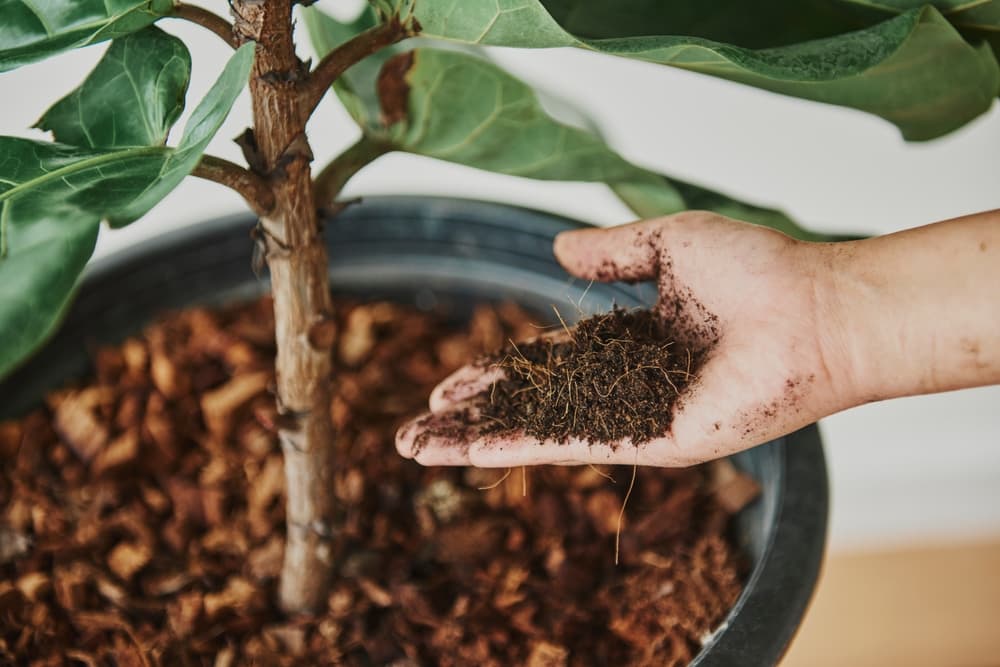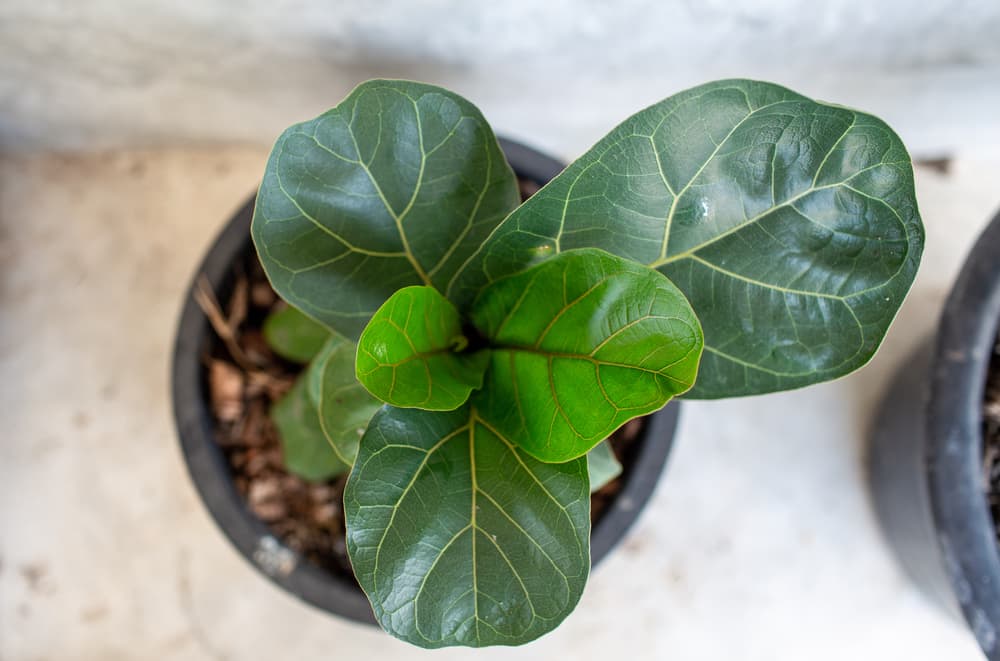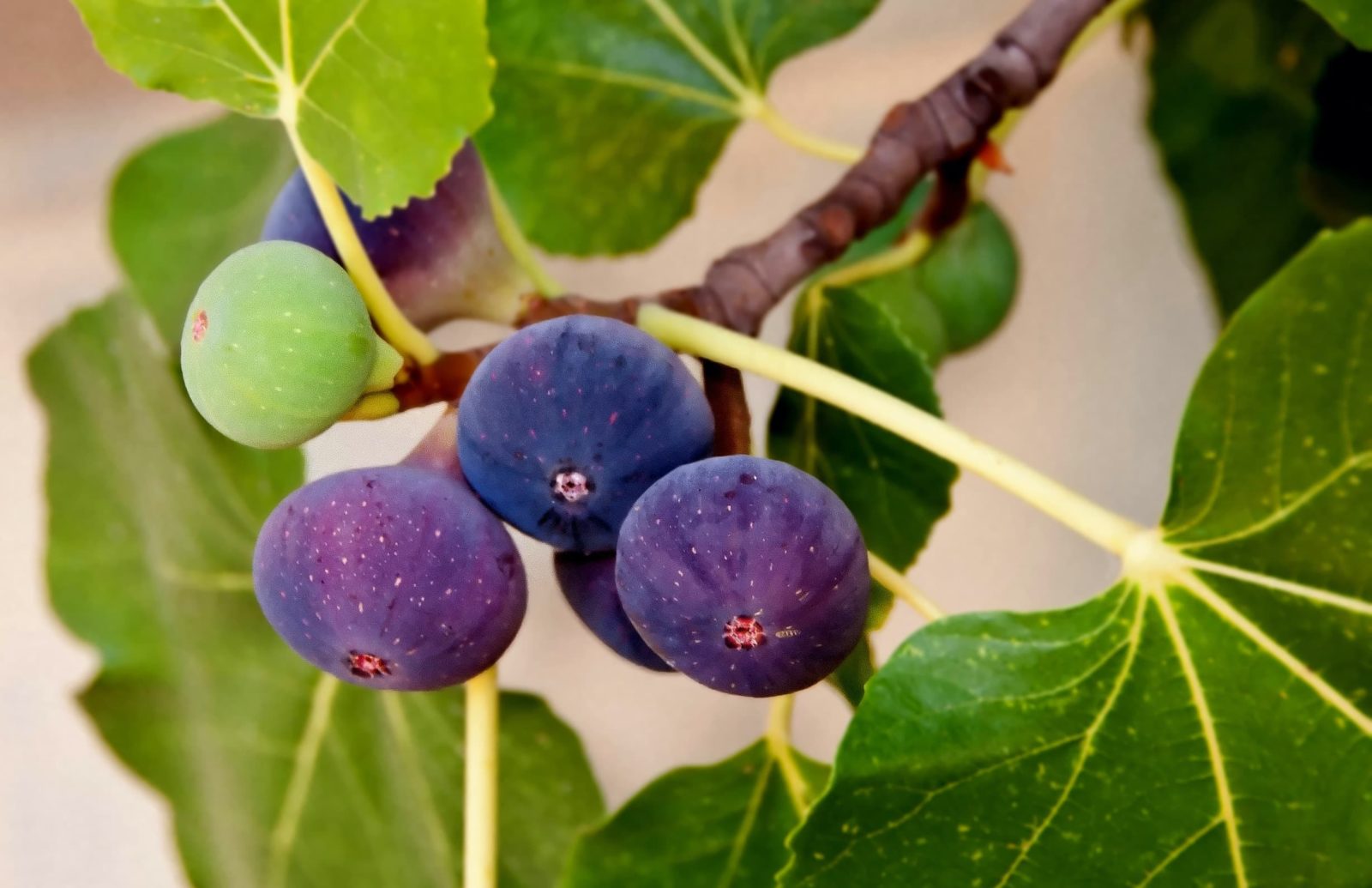HOUSEPLANTS > FICUS > LYRATA
Chris is a gardening writer and nature enthusiast. He graduated from Oxford Brookes University in 2022 with an MA in Psychology. Chris works with the Leeds Green Action Society, helping their food cooperative by growing various fruit and vegetables on their two allotments in Hyde Park, Leeds.
Reviewed By COLIN SKELLY

Colin is a Horticulturist and Horticultural Consultant with experience in a range of practical and managerial roles across heritage, commercial and public horticulture. He holds the Royal Horticultural Society’s Master of Horticulture award and has a particular interest in horticultural ecology and naturalistic planting for habitat and climate resilience.
FICUS GUIDES
Ficus Benjamina
– Drooping Leaves
Fiddle Leaf Fig
Rubber Plant
The name ‘Fiddle-Leaf Fig’ rolls off the tongue nicely, and this is definitely a plant to get yourself acquainted with.
Hailing from Central & Western Africa, this fig variety has since been cultivated and domesticated, guaranteeing its reputation as a popular staple in our gardens and homes.1Datiles, M. J., & Acevedo-Rodrígue, P. (2014). Ficus lyrata (fiddle-leaf fig). CABI Compendium. https://doi.org/10.1079/cabicompendium.24125
While the plant is definitely in vogue, you should know that some people consider it to be quite finickity.
Getting it firmly established in satisfactory conditions can take some work, and if you grow it outdoors, you’ll have to bring it indoors over winter.
With that in mind, though, the rewards offered by getting a fiddle-leaf fig properly settled far outweigh the work involved.
Overview
| Botanical Name | Ficus lyrata |
| Common Name(s) | Fiddle Leaf Fig Tree |
| Plant Type | Houseplant |
| Native Area | Tropical Africa |
| Hardiness Rating | H1B |
| Foliage | Large, fiddle-shaped leaves |
| When To Sow | June, July, August |
| When To Prune | February, March |
Sunlight
Preferred
Indoors / Full Sun Outdoors During Summer
Exposure
Sheltered
Size
Height
4 – 8M
Spread
1 – 1.5M
Soil
Preferred
Most Soil Types
Moisture
Moist but well drained
pH
Any
Fiddle-leaf fig is the common name for Ficus lyrata, a flowering plant in the Moraceae family, otherwise known as figs and mulberries.2Ficus lyrata. (n.d.). Global Plants – JSTOR. Retrieved March 15, 2023, from https://plants.jstor.org/stable/10.5555/al.ap.flora.fwta3535
Unfortunately, however, this member of the family doesn’t put forth fruit when grown indoors, and the fruits it does put forth outdoors are inedible.
For those hoping for a tasty bounty from your fruit tree, we recommend looking elsewhere.

Out in nature, this plant has a fearsome reputation.
As an epiphyte, the fiddle-leaf fig deposits its seeds on top of other trees and then grows downward toward the ground.3Ficus lyrata. (n.d.-b). North Carolina Extension Gardener Plant Toolbox. Retrieved March 15, 2023, from https://plants.ces.ncsu.edu/plants/ficus-lyrata/
While this may sound innocent, the branches wind their way around the host tree, gradually strangling it and starving it of resources.
“As a houseplant, this is a great way to bring a piece of the West African rainforest into your living room,” shares Horticulturist Colin Skelly.
“In a pot, you are keeping it as a seedling compared to its growth habit in its native range.”
When grown as a houseplant these tendencies are unlikely to reveal themselves, so you’ve got nothing to worry about.
How To Grow A Fiddle-Leaf Fig Tree
The Fiddle Leaf Fig can be relatively demanding compared to other houseplants, but we wholeheartedly recommend it.
Soil Requirements
This plant requires well-aerated soil that promotes fast drainage.
It’s not fussy in terms of growing medium – sand, clay, chalk, and loam are all fine – but you must ensure that the roots do not become saturated.

It’s not fussy with acidity, either: acid, alkali, or neutral soils will all work.
You can also get specially-formulated fiddle-leaf fig nutrient mix to ensure the soil remains suitably nutritious for your new green friend.
Hardiness
This plant has a hardiness rating of H1B, indicating that it can be grown outside in summer (doing best in temperatures of 10-15°C or above).
Given the plant’s African origins, this makes sense.
The fiddle-leaf fig evolved in an area of high temperature and frequent sunshine, meaning that a move to often-soggy British climes can be a bit of a shock to the system.
It’s still possible to grow a fiddle-leaf fig in your garden, however – you just need to take the appropriate actions by moving it indoors over the colder months.
Container Growing
Given that you’ll need to move your plant around a lot, it makes sense to grow it in a container.
This plant enjoys being outdoors – it likes the fresh air, the humidity and the sunlight.

When growing your fiddle-leaf fig outdoors, look for a sheltered west- or south-facing spot in direct sunlight, if possible.
Be vigilant for leaf burn, which can be caused by particularly intense periods of sunshine.
Because many leaves grow out of a single bud, it can take a while for lost leaves to be replenished.
Ongoing Care
Aside from ensuring the environment is suitable for your fiddle-leaf fig, it’s actually quite easygoing.
It’ll need a very light pruning once in a while, and there are a few potential pests to be aware of – beyond that, it’s plain sailing.
Pruning
The fiddle-leaf fig tree is a proud member of RHS’ pruning group 1; thus requiring “little to no pruning”.4Shrubs and trees: light pruning. (n.d.-b). Royal Horticultural Society. Retrieved March 15, 2023, from https://www.rhs.org.uk/plants/types/trees/trees-shrubs-light-pruning
This bodes well for the casual gardeners amongst us, and goes some way to offset the tree’s demanding environmental needs.
Give your plant a light pruning in late winter or early spring.
All you’re looking to do is remove diseased or damaged shoots and any that are crossing each other or growing in unwanted directions.
After you’ve done that, mulch and feed the soil to give your plant a nutrient boost.
Winter Care
While they can acclimatise partly to cold, freezing temperatures can cause shock and loss of foliage.
While fiddle-leaf figs are fussy when being moved, they’ll respond well to a move to a more suitable environment.
And in winter, without being moved indoors they will almost certainly die off in outdoor conditions in the UK.

By growing yours in a pot it can be moved easily when the time feels right, but there are also a few steps you can take to ease the transition –
- Move to a shady spot outdoors for a couple of weeks to get your plant used to lower light conditions.
- Use a grow light to simulate sunlight and help your fiddle-leaf fig acclimatise to the dark depths of winter.
- Go steady on the watering: check the top two inches of soil with your finger and only water when these are dry.
- Keep your plant away from radiators, heaters, or any other sources of hot air, as this can further disrupt their already-sensitive humidity requirements.
Any and all of these steps should help out with any transition from the summer outdoors to overwintering indoors.
Common Problems
Few plants are free of risk from opportunistic pests, and the fiddle-leaf fig tree is no different. Here are the main offenders:
Glasshouse Red Spider Mite
These minuscule nuisances feed on the sap in plant leaves, which can lead to mottled leaves and even leaf loss in severe cases.
They’re especially prevalent in summer and, given that your fiddle-leaf fig will be spending its summers outdoors, you need to be vigilant.

If you catch an infestation early, you’ve got a better chance of controlling it.
You can deliberately introduce predatory insects to eat the red spider mites, or you can use solutions such as neem oil or insecticidal soap.
Thrips
Thrips are another small sap-sucking insect that can damage the leaves of your prized fiddle-leaf fig.
If you notice discolouration on your leaves, see whether you can find any thrips lurking under the leaves.
Methods of control are similar: predatory mites or a variety of pesticides.

You can also hang sticky fly-catching sheets if your plant is indoors, as this will attract the thrips away.
Don’t do this outside, however, as you’ll likely catch and kill many innocent flying creatures.
Mealybugs
Mealybugs also like to eat sap, and in exchange for this tasty sustenance, they leave a sticky trail on your leaves which can give rise to mould.
Look for fluffy wax, small white woodlouse-y bugs, or black mould – all indicate visiting mealybugs.
And when you have visitors, your choices are pesticides, tolerating small amounts of damage, or, sadly, destroying heavily infested plants.
A fiddle-leaf fig tree is a stylish addition to any home or garden – and if you’re up for a challenge, you could soon be the proud owner of a thriving specimen.
References
- 1Datiles, M. J., & Acevedo-Rodrígue, P. (2014). Ficus lyrata (fiddle-leaf fig). CABI Compendium. https://doi.org/10.1079/cabicompendium.24125
- 2Ficus lyrata. (n.d.). Global Plants – JSTOR. Retrieved March 15, 2023, from https://plants.jstor.org/stable/10.5555/al.ap.flora.fwta3535
- 3Ficus lyrata. (n.d.-b). North Carolina Extension Gardener Plant Toolbox. Retrieved March 15, 2023, from https://plants.ces.ncsu.edu/plants/ficus-lyrata/
- 4Shrubs and trees: light pruning. (n.d.-b). Royal Horticultural Society. Retrieved March 15, 2023, from https://www.rhs.org.uk/plants/types/trees/trees-shrubs-light-pruning

